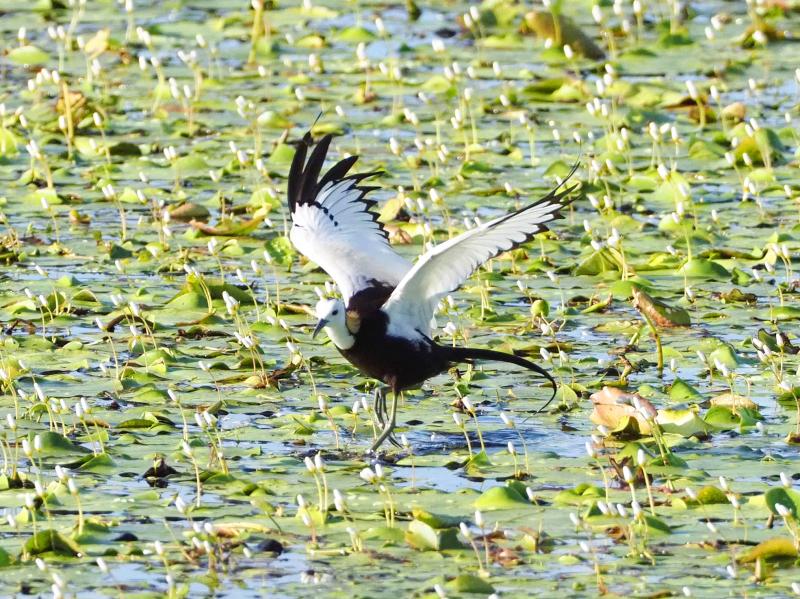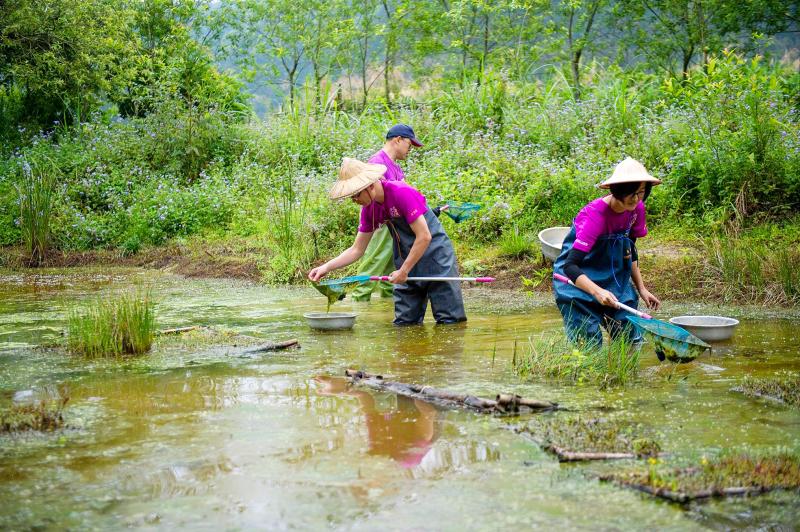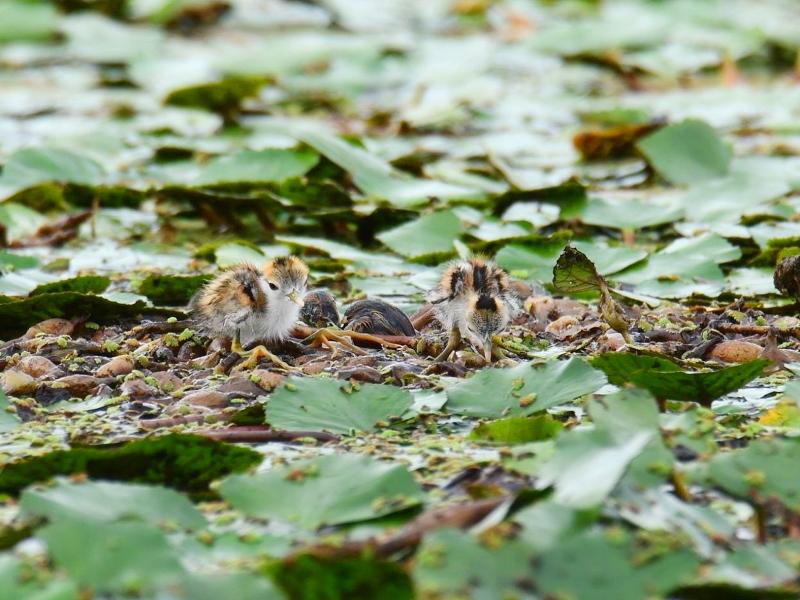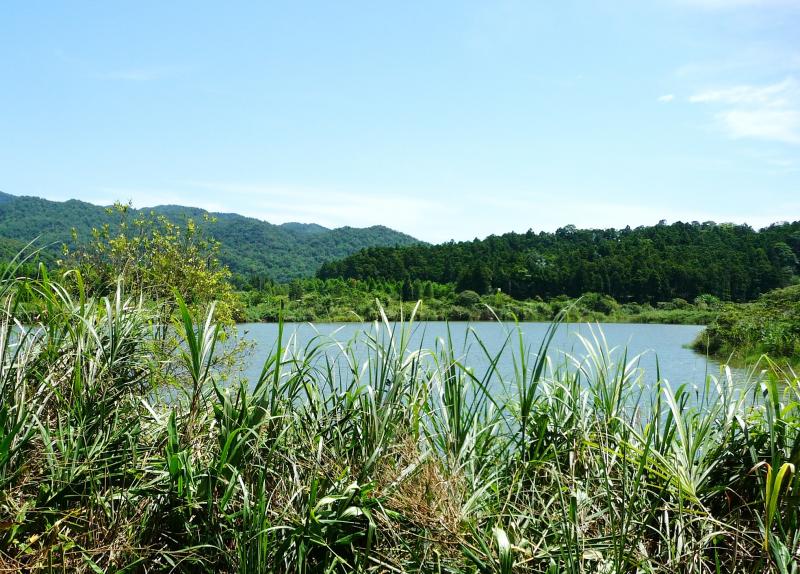Writing about environmental issues can be dispiriting, but the outlook isn’t entirely bleak. Here in Taiwan, in recent decades, public attitudes to the environment have certainly changed for the better — even if citizens’ daily behavior doesn’t always reflect the priorities they express in opinion surveys.
In this country as elsewhere, non-governmental organizations (NGOs) make it easier for concerned citizens to support and participate in conservation work. Nonprofits have played a key role in several successful environmental projects, including the two profiled below.
SOCIETY OF WILDERNESS AND SHUANGLIANPI

Photo courtesy of Meinong Lake Jacana Conservation Area Volunteers
Protection of habitats and natural ecosystems is a core objective of Society Of Wilderness (SOW, 荒野保護協會, www.sow.org.tw), a Taipei-headquartered NGO.
At 80 locations around Taiwan, volunteers from its 11 local chapters take part in ecological survey and monitoring work, habitat preservation, species restoration, the removal of invasive species and environmental education.
“The largest and most successful case we’ve been involved in is Shuanglianpi (雙連埤) in Yilan, a wetland in a low-elevation mountainous area,” says SOW Secretary-General Lua Jane-lung (劉建隆).

Photo courtesy of Society of Wilderness
Agricultural development throughout the 20th century several damaged the area’s ecosystems, Lua explains. However, SOW successfully lobbied the local and national governments to bring the site under the protection of laws such as the Wetland Conservation Act (濕地保育法). In 2003, 17.16 hectares of dry land and water, around 480m above sea level in Yuanshan Township (員山), was designated Shuanglianpi Wildlife Refuge (雙連埤野生動物保護區).
The central government provided NT$53 million for the purchase of privately-owned land, to ensure that the source of the wetland’s water is under government control.
According to the Forestry Bureau’s Web site, the goal of the wildlife refuge is to sustainably preserve the genetic biodiversity of the wetland and its surrounding Machilus-Castanopsis sub-montane evergreen broadleaved forest.

Photo courtesy of Meinong Lake Jacana Conservation Area Volunteers
Depopulation makes this task easier. Since the 1980s, many of the descendants of those who worked hard to convert the wilderness around Shuanlianpi into productive farmland have relocated to the lowlands. What used to be an elementary school campus, closed down in 1993 due to a lack of school-age children, served for a while as SOW’s ecological classroom.
At least a third of Taiwan’s aquatic plant species can be found within the refuge. Among the 112 types of aquatic plant identified here are Salix kusanoi (水社柳, an endemic willow species), Trapa incisa var. Sieb. (野菱, a type of herb) and watershield (蓴菜等, Brasenia schreberi).
Certain rare aquatic plants that disappeared from Shuanglianpi due to human interference have been successfully reintroduced, thanks to the joint efforts of SOW and the Wistron Foundation (the charitable arm of electronics manufacturer Wistron Corp), Lua says.

Photo: Steven Crook
The grassy habitat surrounding the water is an ideal breeding ground for aquatic insects. There have been recorded sightings of 58 dragonfly species, 32 species of other aquatic insects and 206 species of terrestrial insects.
Among amphibian creatures often spotted at Shuanglianpi are Bufo bankorensis, (盤古蟾蜍) an endemic toad and Zhangixalus prasinatus (翡翠樹蛙, sometimes called the emerald green treefrog). In addition to being found nowhere in the world except for northern Taiwan, the latter is the country’s largest tree frog. As you’d expect in a place where an abundance of insects keeps its frogs and toads well fed, there are also snakes.
Conservation efforts at Shuanglianpi don’t exclude human history.
Stone cottages built by Hakka pioneers, such as the Zou Family Ancient Abode (鄒家古厝), are being preserved.
The hand-dug ditches that once irrigated fields near the wetland, and which fell into disrepair as people moved away, are being restored. In 2019, the Forestry Bureau commissioned the Environmental Ethics Foundation of Taiwan (人禾環境倫理發展基金會) to interview local elders, so traditional techniques could be relearned, and to deploy local manpower to restore these channels.
BIRD ENTHUSIASTS CREATE A NEW HOME FOR THE JACANA
Humans have destroyed countless habitats. They’ve also created some, more often by accident than by design.
Over the past five years, thanks largely to the efforts of Huang Shu-mei (黃淑玫) and her husband, Liu Hsiao-shen (劉孝伸), Meinong Lake (美濃湖) has become a breeding ground for a waterbird species that nests at just a handful of sites in Taiwan.
In 2017, Huang and Liu signed a lease on a one-hectare plot of land beside the lake, which is 40km northeast of downtown Kaohsiung. With the help of friends and volunteers, they began removing invasive plants and introducing aquatic plant species likely to attract the Pheasant-tailed jacana (Hydrophasianus chirurgus).
The jacana is an exceptionally alluring bird, and Huang hoped that, if the site became known as one of its breeding grounds, its presence would inspire visitors to take an interest in birds and, by extension, the habitat’s butterflies, dragonflies and plants.
“Before 2017, many Pheasant-tailed jacanas would spend the winter in Meinong, but they’d leave in the spring and nest elsewhere,” Huang says.
A major cash crop in the area is white water snowflake (野蓮, Nymphoides hydrophylla). Farmers who cultivate this vegetable don’t use a lot of agrochemicals, so there’s always an abundance of insects on which the jacanas can feed, Huang says.
To create an environment suitable for nesting jacanas, Huang obtained specimens of water caltrop (菱角, Trapa bicornis), Euryale ferox (芡實, prickly waterlily) and Nymphaea lotus (齒葉睡蓮, white Egyptian lotus). These were purchased or donated from Guantian (官田) in Tainan and from two locations in Kaohsiung, Kaotan (拷潭) and Weiwuying Metropolitan Parks (衛武營都會公園).
As far as bird enthusiasts are concerned, Guantian is synonymous with the Pheasant-tailed jacana. By the 1990s, this species was fast disappearing from Taiwan, even though it remained common in Southeast Asia. It looked as if Taiwan’s jacanas would make a last stand in the water-caltrop fields of Guantian — but an outpouring of concern, backed by practical measures such as the creation of the Jacana Ecological Education Park (水雉生態教育園區) in Guantian, reversed their decline.
The Meinong Lake project has been a success: Each year, jacanas nest and raise chicks in the new habitat. However, Huang says, it’s faced a number of challenges, among them rising costs, unfavorable weather and fluctuating water levels.
“We paid NT$50,000 rent for the first year. By the third year, however, the landlord was asking for NT$120,000,” says the retired teacher.
This increase is a consequence of farmers seeking plots where white water snowflake can be grown, she explains.
Realizing that the project was becoming too expensive to continue financing it by themselves, in 2020 Huang and Liu formalized a group of 69 supporters who pitched in a total of NT$465,000. Around the same time, Kaohsiung Wild Bird Society (KWBS) took over the site’s management.
Last year’s severe drought killed off many aquatic plants. Later, torrential rains killed some of the newborn jacanas.
Because Meinong Lake stores water for irrigation and acts as a flood-detention basin during the rainy season, Huang accepts that the water level will often deviate from what’s ideal for the jacana habitat.
In the early days, some locals complained that the fences erected around the jacana habitat to keep out cats and dogs were unsightly. But now that the plants and trees added to the site have matured, they’re more likely to compliment its appearance, Huang says.
Recognizing that what’s officially called Meinong Lake Jacana Conservation Area (美濃湖水雉棲地) is likely to draw more visitors to the area, Kaohsiung City Government Tourism Bureau is backing KWBS’s effort to develop a second jacana-friendly habitat next to the lake.
KWBS is also in charge of an aquatic-plant seedlings pond and a habitat workstation. The NGO has helped educate farmers that the jacanas eat insects which might otherwise harm their crops. Farmer patrol groups that check on nesting sites each month are subsidized by the Forestry Bureau.
Individuals, NGOs, and government units don’t always mesh. But Meinong Lake’s jacana project shows what can be achieved when stakeholders all pull in the same direction.
Steven Crook, the author or co-author of four books about Taiwan, has been following environmental issues since he arrived in the country in 1991. He drives a hybrid and carries his own chopsticks. The views expressed here are his own.

April 14 to April 20 In March 1947, Sising Katadrepan urged the government to drop the “high mountain people” (高山族) designation for Indigenous Taiwanese and refer to them as “Taiwan people” (台灣族). He considered the term derogatory, arguing that it made them sound like animals. The Taiwan Provincial Government agreed to stop using the term, stating that Indigenous Taiwanese suffered all sorts of discrimination and oppression under the Japanese and were forced to live in the mountains as outsiders to society. Now, under the new regime, they would be seen as equals, thus they should be henceforth

Last week, the the National Immigration Agency (NIA) told the legislature that more than 10,000 naturalized Taiwanese citizens from the People’s Republic of China (PRC) risked having their citizenship revoked if they failed to provide proof that they had renounced their Chinese household registration within the next three months. Renunciation is required under the Act Governing Relations Between the People of the Taiwan Area and the Mainland Area (臺灣地區與大陸地區人民關係條例), as amended in 2004, though it was only a legal requirement after 2000. Prior to that, it had been only an administrative requirement since the Nationality Act (國籍法) was established in

Three big changes have transformed the landscape of Taiwan’s local patronage factions: Increasing Democratic Progressive Party (DPP) involvement, rising new factions and the Chinese Nationalist Party’s (KMT) significantly weakened control. GREEN FACTIONS It is said that “south of the Zhuoshui River (濁水溪), there is no blue-green divide,” meaning that from Yunlin County south there is no difference between KMT and DPP politicians. This is not always true, but there is more than a grain of truth to it. Traditionally, DPP factions are viewed as national entities, with their primary function to secure plum positions in the party and government. This is not unusual

US President Donald Trump’s bid to take back control of the Panama Canal has put his counterpart Jose Raul Mulino in a difficult position and revived fears in the Central American country that US military bases will return. After Trump vowed to reclaim the interoceanic waterway from Chinese influence, US Defense Secretary Pete Hegseth signed an agreement with the Mulino administration last week for the US to deploy troops in areas adjacent to the canal. For more than two decades, after handing over control of the strategically vital waterway to Panama in 1999 and dismantling the bases that protected it, Washington has